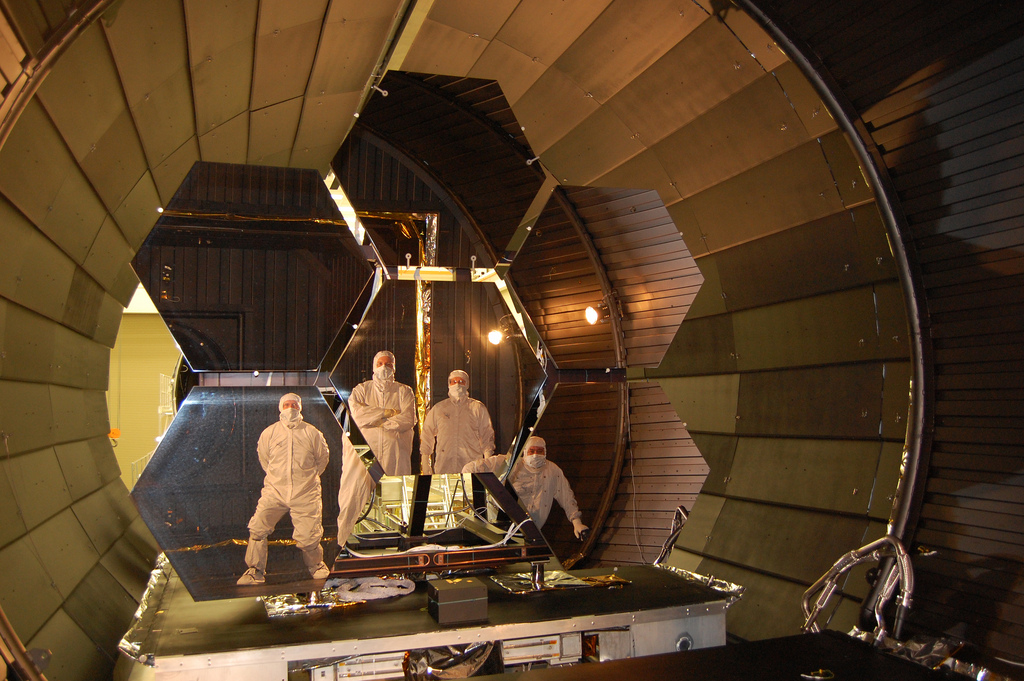James Webb Space Telescope

The full-scale model was assembled on the lawn at Goddard Space Flight Center, and displayed during September 19 - 25 2005. (Credit: NASA)
The James Webb Space Telescope is a very large and powerful telescope that will study the Universe from space at infrared wavelengths. It is currently in development and scheduled to launch in 2021. Webb is an international collaboration between NASA, the European Space Agency (ESA), and the Canadian Space Agency (CSA). The NASA Goddard Space Flight Center is managing the development effort, and Dr. John Mather, Nobel laureate, is the Senior Project Scientist for this program.
Webb will be the premier observatory of the next decade, serving thousands of astronomers worldwide, just like the Great Observatories (Hubble, Chandra, Spitzer, and Compton). It will study four main science themes:
- The End of the Dark Ages: First Stars and Reionization – identifying the first bright objects that formed in the early Universe and understanding what happened before.
- The Assembly of Galaxies – determining how galaxies, and the dark matter, gas, stars, metals, black holes, and physical structures (like spiral arms) within them, evolved to the present day.
- The Formation of Stars and Protoplanetary Systems – focusing on the birth and early development of stars and the formation of planets.
- Planetary Systems and the Origins of Life – studying the physical and chemical properties of solar systems (including our own) and where the building blocks of life may be present.
The observations needed to accomplish these goals require a large telescope that can study the universe in infrared light. Hence, Webb will have a 6.5 meter diameter mirror and its instruments will be able to cover the range from 0.6 to 28.5 micrometers (or "microns"; 1 micron is 1 x 10-6 meters). This gives Webb sensitivity to wavelengths of light ranging from the red part of the visible spectrum deep into the infrared.
Additionally, since infrared radiation is basically heat, instruments on infrared telescopes need to be very cold to avoid being swamped by the heat radiating from the telescope itself. The instruments must be at temperatures just a few tens of degrees above absolute zero. To aid in this goal, Webb will reside far from the Earth at the L2 region.
There will be four science instruments on Webb:
- NIRCam is a near-infrared camera that will be the primary imager on Webb.
- NIRSpec is a near-infrared multi-object spectrograph in the wavelength range of 0.6 to 5 microns.
- MIRI is a mid-infrared instrument and will provide imaging and spectroscopy at wavelengths of 5 to 28.5 microns.
- FGS is the fine guidance sensor, a sensitive camera that provides dedicated, mission-critical support for the observatory's attitude control system.

Six of the 18 James Webb Space Telescope mirror segments being prepped to move into the X-ray and Cryogenic Facility, or XRCF, at NASA's Marshall Space Flight Center in Huntsville, AL. (Credit: NASA/MSFC/Emmett Givens)

Comparison of Webb and Hubble Space Telescope mirrors. (Image credit: NASA)
Several innovative new technologies have been developed for this next generation space telescope to enable the ground-breaking discoveries Webb is expected to make. Two of these are discussed below:
- A light-weight, segmented mirror that can be folded up inside the launch rocket and unfold after launch.
To accomplish its science goals, Webb requires a large mirror. But a regular mirror would weigh too much to be launched efficiently. And if the mirror were assembled completely and fully opened on the ground, there would be no way to fit it into a rocket. Engineers solved this problem by using beryllium, a very light-weight material, to construct the mirror. They also came up with a design that allows the segmented mirror to fold, like the leaves of a drop-leaf table. Therefore, Webb's primary mirror can be 6.5 meters in diameter, which is more than 2.5 times larger than the diameter of the Hubble Space Telescope's primary mirror, but will weigh roughly half as much. The telescope will be launched with the mirror segments folded up. The mirrors will unfold and be set into place when the telescope is in space.
- Microshutters


The microshutters on the James Webb Space Telescope's NIRSpec instrument. (Credit: NASA)
In order to be able to study large numbers of distant objects at one time, scientists need to be able to block out the light of brighter nearby objects. The microshutters were developed to help solve this problem. Microshutters are tiny cells that measure 100 by 200 microns, or about the width of three to six human hairs. The microshutter cells have lids that open and close when a magnetic field is applied. Each cell can be controlled individually, allowing it to be opened or closed to view or block a portion of the sky. It is this adjustability that allows the instrument to do spectroscopy on so many objects simultaneously.
To learn more about these cool new technologies and about Webb, please visit the website at http://www.jwst.nasa.gov/.
class="imagineCaption">This video shows in-depth what will happen when JWST deploys after launch.
(Credit: Northrop Grumman)
Published: April 2007
Text Reviewed: September 2018


